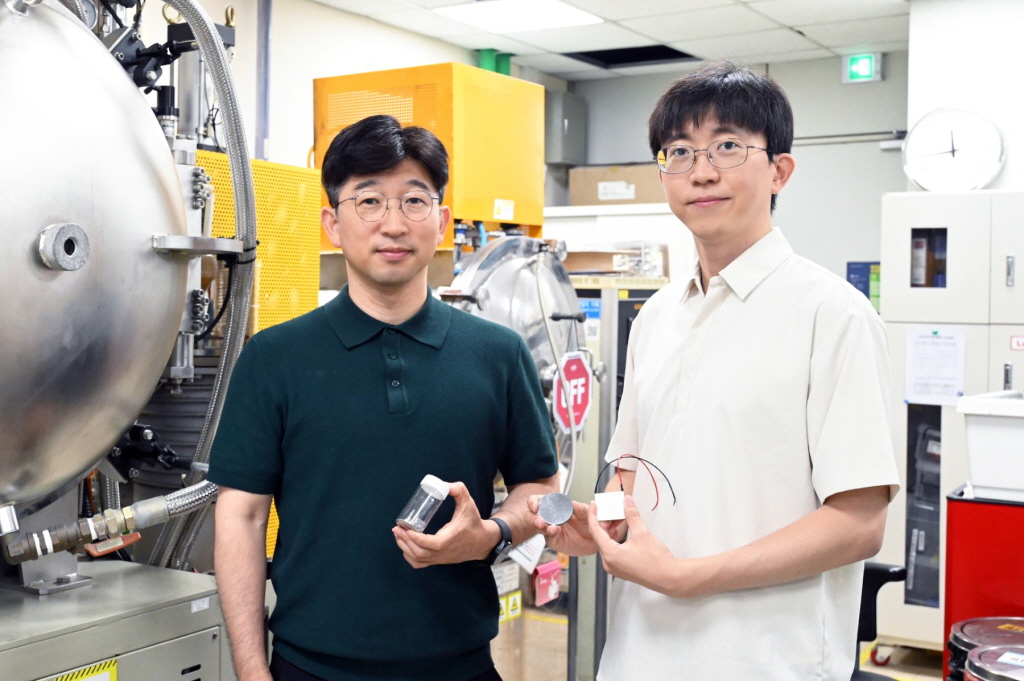한국재료연구원(KIMS, 원장 최철진) 나노재료연구본부 김경태 박사 연구팀이 원자 규모의 결함을 인위적으로 형성한 비스무트 텔루라이드(Bi-Te)계 열전반도체 재료를 개발하고, 버려지는 열에너지를 활용하기 위한 물성 향상 솔루션을 제시하며, 수십년간 정체됐던 n형 열전반도체 연구의 돌파구가 마련될 것으로 기대된다.

▲연구개발책임자 김경태 책임연구원(左), 논문 제 1저자인 정수호 선임연구원(右)
나노구조 열전반도체 소재공정기술 개발
각종 산업 및 수송 분야에서 발생하는 폐열을 재활용해 전기를 생산하는 열전발전소자의 물성 향상과 상용화를 위한 솔루션이 제시돼 향후 수십년간 정체됐던 n형 열전반도체 연구의 돌파구가 마련될 것으로 기대된다.
한국재료연구원(KIMS, 원장 최철진)은 나노재료연구본부 김경태 박사 연구팀이 원자 규모의 결함을 인위적으로 형성한 비스무트 텔루라이드(Bi-Te)계 열전반도체 재료를 개발하고, 버려지는 열에너지를 활용하기 위한 물성 향상 솔루션을 제시했다고 7일 밝혔다.
이 기술은 공장, 자동차, 선박 엔진 등 산업 및 수송 분야에서 발생하는 200℃ 이하의 폐열을 재활용해 전기를 생산하는 열전발전소자에 적용되는 반도체 기술이다.
열전발전소자는 온도 차이와 전기에너지가 상호 간 가역적으로 변환되는 p형과 n형의 반도체 조합으로 이뤄진다.
지금까지는 비스무트(Bi)와 텔루륨(Te)으로 이루어진 p형 열전소재의 물성향상 연구가 중점적으로 진행됐다.
반면에 셀레늄(Se)이 포함된 n형 열전반도체는 성분 조절과 미세조직 제어가 어려운 탓에 물성 향상이 더디어 열전발전소자 상용화에 걸림돌로 지적됐다.
연구팀은 열전발전소자 성능을 결정하는 n형 열전반도체 연구에 집중해, 수십년간 정체된 물성향상의 돌파구를 제시했다. 돌파구의 핵심은 도핑소재와 제조과정에 있다.
도핑소재는 반도체의 전기 전도성을 향상시키기 위해 첨가하는 원소다. 연구팀은 도핑소재로 안티모니(Sb)를 포함한 p형 비스무트 텔루라이드 열전반도체가 최적의 성능을 달성할 가능성이 높다는 점에 착안해 n형 열전반도체에 통상적인 도핑소재인 셀레늄(Se) 대신 안티모니(Sb)를 집어넣고도 n형 특성을 나타내는 소재를 개발했다.
또한 연구팀은 n형 열전반도체 제조 과정에서 전자 형성을 촉진하는 ‘원자 결함’과 열전달 매개체인 격자 포논의 전달을 늦추는 ‘원자층 간의 비틀림’을 인위적으로 유도해, 전기전도도는 증가시키고 열전도도는 낮추는 방법을 개발했다. 해당 기술은 분말 형태로 된 소재를 틀에 넣고 가열한 후 찍어내는 방법을 이용하기 때문에 설계한 형상과 크기로 열전반도체를 제조하기 용이한 장점이 있다.
본 기술을 통해 개발된 n형 열전반도체는 전기전도도를 2배 이상 향상시키면서도 열전도도는 감소하는 등 열전소자에 필요한 열-전기 물성을 명확하게 나타냈다. 특히, 인체열을 비롯해 우리 주변에서 버려지는 상온에서 200℃ 부근의 열을 재활용할 때, 에너지변환 성능과 재료 조합이 용이한 연구팀의 열전반도체 기술 적용이 기대된다.
열전발전소자 시장은 연평균 성장률 8.2%로 증가하고 있으며, 2029년에는 전 세계적으로 10억 1,800만 달러에 이를 것으로 전망될 정도로 높은 관심을 끌고 있다. 연구팀은 ㈜리빙케어와 협업을 통해 열전발전소자 개발을 추진 중이다. 또한 현대자동차 울산공장과의 협력을 통해 주조금형에서 발생하는 폐열 회수를 위한 발전 시스템 구축 시범 연구를 진행 중이다.
연구책임자인 김경태 책임연구원은 “이번 연구는 200℃ 이하의 각종 배·폐열 재활용에 걸림돌이 되었던 n형 열전반도체 소재 물성제어를 해결하는 디딤돌을 마련했다”며 “전통적인 분말야금 기술로 원자수준의 결함이 제어된 나노구조 열전반도체 소재기술을 개발한 데 의의가 있다”고 말했다.
본 연구성과는 한국재료연구원 기본사업 및 한국연구재단 브릿지융합사업(폐열회수열전융합연구단)의 지원으로 수행됐다. 또한 연구 결과는 세계적 학술지인 미국화학회‘어플라이드 머터리얼스 앤 인터페이스(ACS Applied Materials & Interfaces, IF: 11.1/ 제1저자 정수호 선임연구원)’에 7월31일자로 게재됐으며, 표지논문으로도 선정됐다.
